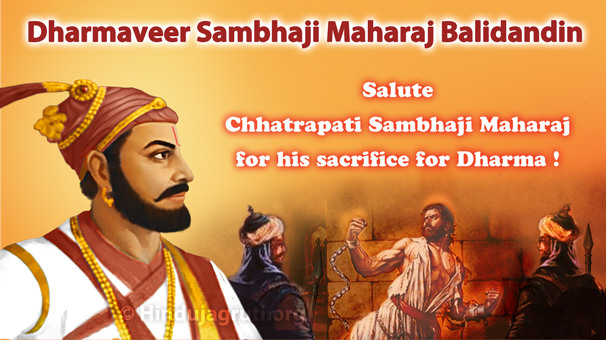
Chhatrapati Sambhaji Maharaj was a true Dharmaveer, who just like his father Chhatrapati Shivaji Maharaj, did not bow before Aurangzeb although Aurangzeb brutally tortured Sambhaji Maharaj for more than 40 days. Hindus must learn how to sacrifice for Dharma from Sambhaji Maharaj. He was a scholar of Sanskrit language. He single handedly fought with the massive army of Aurangzeb for 9 years. He and Maratha rulers after him kept Aurangzeb in Maharashtra for 27 years, which finally resulted in the establishment of Hindu rule in North India. Sambhaji Maharaj also fought with the Portuguese in Goa, as they were orchestrating the mass conversions of Hindus and had demolished Hindu Temples in Goa. The detailed information about Sambhaji Maharaj is as follows :
Early Life
Sambhaji Maharaj lost his mother Sai bai at the age of 2. After her death, his paternal grandmother Jijabai looked after him. Initially his stepmother, Soyarabai, also doted on him a lot. Sambhaji Maharaj was a tiger cub in the true sense. He was extremely handsome and possessed immense bravery. He was a scholar of Sanskrit and eight other languages. In 1666, he was married to Yesu bai, and later the couple had a son – Shahu. On June 6th, 1674 at the time of the coronation of Shivaji Maharaj, he was declared the prince of the Sovereign Maratha Kingdom. Many visiting dignitaries at the coronation ceremony have written about his acumen, intelligence, personality and most important of all, his modesty. As a prince, Sambhaji Maharaj proved his bravery and military brilliance on more than one occasion. He led and won his first war at Ramnagar at the age of 16. During 1675-76 he led successful campaigns in Goa and Karnataka.
Estrangement and reconciliation with his father
The politics fuelled by the wife Soyarabai, of Shivaji Maharaj, with some other courtiers led to Sambhaji Maharaj’s estrangement. For almost one year, Sambhaji Maharaj left Shivaji Maharaj’s kingdom and joined Aurangzeb’s commander, Diler Khan as part of politics. This came as a rude and extremely sad shock to Shivaji Maharaj. This process caused further widening of the rift between Sambhaji Maharaj on one side, and Soyarabai on the other. As a result, Sambhaji Maharaj was not invited for Rajaram’s wedding and moreover he was not even informed of the sudden death of Chhatrapati Shivaji Maharaj a few days thereafter. Rajaram was the child of Shivaji Maharaj & Soyarabai.
Coronation

Soyarabai and her supporters plotted to arrest Sambhaji Maharaj at the fort of Panhala, where he was staying at the time of Shivaji Maharaj’s death. They wanted to crown Rajaram and not allow Sambhaji Maharaj to become the Maratha emperor. However Sarnobat (the Supreme Commander of the Maratha forces) and Soyarabai’s brother, Hambirrao Mohite supported Sambhaji Maharaj since he was the rightful heir to the throne. At the time of Shivaji Maharaj’s death, there was news of an impending attack of Aurangzeb’s army on Maharashtra and at such a crucial juncture, a strong leader like Sambhaji Maharaj was the need of the hour. Therefore Hambirrao did not support his own sister and sided instead with Sambhaji Maharaj.
Annaji Datto Sabnis and other courtiers namely Hiroji Bhosale (Farjad), Balaji Aavji and Rupaji Mane were arrested for supporting Soyarabai and were punished in a rather cruel way, by being killed when trampled upon by War-elephants. It was chiefly because of Hambirrao’s support that Sambhaji Maharaj was able to ascend to his rightful place on the Maratha throne in 1681.
Sambhaji Maharaj kept Aurangzeb away from North India for 27 years

The remarkable things that Sambhaji Maharaj achieved in his short life had far-reaching effects on the whole of India. Every Hindu should be grateful to him for that. He valiantly faced the 8 lakh strong army of Aurangzeb and defeated several Mughal chieftains in the battlefield forcing them to retreat. Because of this, Aurangzeb remained engaged in battles in Maharashtra, thus keeping the rest of India free from Aurangzeb’s tyranny for a long time. This can be considered as the greatest achievement of Sambhaji Maharaj. If Sambhaji Maharaj would have arrived at a settlement with Aurangzeb and accepted his proposal of being a tributary prince, then within the next 2 or 3 years Aurangzeb would have captured North India again. However, because of Sambhaji Maharaj and other Maratha ruler’s (Rajaram and Mahraani Tarabai) struggle, Aurangzeb was stuck in battles in South India for 27 years. This helped in the establishment of new Hindu kingdoms in the provinces of Bundelkhand, Punjab and Rajasthan in North India; thus providing safety to the Hindu society there.
War with the Mughals
It would be appropriate to examine the facile charge that Sambhaji Maharaj lost his father’s kingdom to Aurangazeb. Let us see what was retained in Maratha hands and how much was lost to the enemy at the time of his cruel death.
The details of the conflict as a whole, during Sambhaji Maharaj’s reign, the progress, if any, of the Mughal armies and the gallant defense offered by the Marathas and their aggressive and retaliatory tactics help us to evaluate the efforts of Sambhaji Maharaj and the Marathas to protect the gains of Shivaji. It also refutes the charge that Sambhaji Maharaj had lost everything.
The Mughals started their aggression in 1681 in Nasik-Baglan in the northern region of South Maharashtra. Till the year 1686, the Mughal forces had not succeeded in capturing any forts. Though the Mughal forces captured some forts during the last 2 years of Sambhaji Maharaj’s reign, Aurangazeb was forced to resort to encouraging treachery. At the end of 1686, Salher fort was taken by the Mughals after bribing the Killedar Asoji with a mansab. Ramsej was also won by treachery in 1687. At the end of 1688 and the beginning of 1689, Mughals got Harishgad, Tringalwadi, Madangad, Mordant, Aundha and Karani by treachery. At the beginning of 1689, Matabarkhan captured Trimabkgad by offering cash and mansab to Shyamraj and Telangrao. Pattagad is an exception to this pattern. It was captured after a straight fight. In short it can be said that the Marathas were in command of almost all their territory till 1686 and in the end only the weapons of treachery and not arms proved effective against them.
The Mughals turned to the central part of southern Maharashtra i.e. Talkonkan, Kalyan-Bhiwandi, Kothalagad, Pune and Satara region from 1681. Matabarkhan who had informed Aurangazeb about the difficulties in these regions, captured Kalyan-Bhiwandi, Purgadi and other other forts in Talkonkan only after the death of King Sambhaji Maharaj.
The Mughals however succeeded in capturing Kothalagad at the end of 1684. Fort Mahuli was captured by Matabarkhan on 21st Aug’1688 by giving a bribe of 2500 Ashrafis to Killedar Dwarkoji.
In the middle of the year 1684, even though Aurangazeb succeeded in taking Surapur, Shirval and Supe, Sambhaji Maharaj continued to hold all the important forts like Rohida, Purandar, Shrivardhan, Rajmachi, Sinhagad, Rajgad and Raigad. At the end of 1687, the Mughals were able to establish their hold on Satara, Parali,Nimb, Chandan, Vandan, Karad, Majgaon and Masar by Sept’1689. From 1689 , the Mughal posted their thanedar at Wai.
In south Konkan, the Marathas held Sangameshwar, Rajapur, Panhala, Malkapur, Khelna, Pargad, Kopal, Bahaddurbanda, Shirole and Phonda till the end of Sambhaji Maharaj’s reign.
In Goa, the Mughals established their rule in Antraj Mahal only from Feb’1689.
In North Konkan, the Marathas had retained their hold on Kulaba, Khanderi, Rajkot, Sagargad, Padmadurga and Cheul and the region around these places.
In Karnataka, The Marathas lost Bengalore, Doddabalapur, Tumkur, Chikanhalli in the year 1687-1688 while they succeeded in retaining their hold on Jingee, Tanjore and territories surrounding these places.
One thing can be said for certain that Aurangazeb who was not wholly successful, won a large part of the Maratha Kingdom immediately and only after Sambhaji Maharaj’s death. The collective leadership under Chhatrapati Rajaram and Tarabai fought very gallantly so that the Mughal emperor could not achieve what he had vowed to do even after a long struggle of quarter of a century. He could never secure full control over the Maratha state. His resolve and ambition to become the master of the south soon after Shivaji Maharaj’s death was foiled by Sambhaji Maharaj and his successor Rajaram.
Well known historian Sir Jadunath Sarkar and Vincent Smith have very aptly opined “If Napolean could say that it was the Spanish ulcer which ruined me, Aurangazeb could also say that the Deccan wars not only undid his own work, but also those of his predecessors”. No wonder Vincent Smith remarks that “the Deccan was not only the grave of his (Aurangazeb’s) body but also his empire”.
It is well said that along with Aurangazeb’s person, his ambition to annihilate the Marathas was also buried deep in the Deccan. One may also add that the generation of brave patriots created by Shivaji Maharaj held against the forces of Aurangazeb for Twenty Five years of agonising privations and against a vast and well equipped force. It can be said that world’s history records few, if any, struggles of such heroic grandeur and inspiring resistance, led by a young king, his still younger brother and a women. Herein lies the real success of the genius of Shivaji Maharaj.
Reference : Short Resume – page 234 CHHATRAPATI SAMBHAJI by DR.KAMAL GOKHALE,Navakamal Pub.,Pune
War with the Portuguese

Sambhaji Maharaj fought against the Portuguese in Goa who were very active in the forceful conversions of Hindus through various means like the ‘Inquisition’. He was very angry with them due to these conversions & the demolition of Hindu Temples in Goa. The Portuguese were very frightened of being assaulted by Sambhaji Maharaj, and this reflects in their letter to the British in which they wrote, ‘Now-a-days Sambhaji Maharaj is the most powerful person and we have experienced it’.
Efforts for Reconversion to Hinduism
We all know that Shivaji Maharaj reconverted Netaji Palkar to Hinduism. However, it is important to note that Sambhaji Maharaj had established a separate department in his province for the ‘reconversion ceremony’ of the Hindus who had earlier converted into other religions. There is a story of a Brahmin named ‘Kulkarni’ of Harsul village in the history of Sambhaji Maharaj. Kulkarni had been forcibly converted to Islam by the Mughals. He tried to reconvert into Hinduism, but local Brahmins in his village did not pay any heed to him. In the end, Kulkarni met Sambhaji Maharaj and told him about his misery. Sambhaji Maharaj immediately arranged for his reconversion ceremony and reconverted him into a Hindu.This noble initiative of Sambhaji Maharaj Maharaj helped many converted Hindus to reconvert back into Hinduism.
Capture and Execution
In early 1689, Sambhaji Maharaj called his commanders for a strategic meeting at Sangameshwar in Konkan. In a meticulously planned operation, Ganoji Shirke (brother of Sambhaji Maharaj’s wife Yesubai) and Aurangzeb’s commander, Mukarrab Khan attacked Sangameshwar when Sambhaji Maharaj was about to leave the town. A small ambush followed and Sambhaji Maharaj was captured by Mughal troops on 1 Feb, 1689. He and his advisor, Kavi Kalash were taken to Bahadurgad. Aurangzeb humiliated them by parading them wearing clown’s clothes. Later, Sambhaji Maharaj and Kavi Kalash were tied upside down to camels with Mughal soldiers throwing stones, mud, and cow dung at them.
When they were brought face to face with Aurangzeb, the latter offered to let Sambhaji Maharaj live if he surrendered all the Maratha forts, turned over all his hidden treasures and disclosed the names of all the Mughal officers who had helped him. Sambhaji Maharaj refused, and instead sang the praises of Mahadev (Lord Shiva). Aurangzeb ordered him and Kavi Kalash to be tortured to death. Sambhaji Maharaj and Kavi Kalash were brutally tortured for over a fortnight. The torture involved plucking out their eyes and tongue and pulling out their nails. The later part involved removing their skin. On March 11, 1689, Sambhaji Maharaj was finally killed, reportedly by tearing him apart from the front and back with ‘Wagh Nakhe’ (‘Tiger claws’, a kind of weapon), and was beheaded with an axe. This grievous death was given to him at Vadhu on the banks of the Bhima river, near Pune.
After every torture, Aurangzeb would ask him if he had had enough and wanted to convert – but the courageous king kept refusing. By doing so he earned the title of Dharmaveer (Protector of Dharma) by which he is known to this day. Aurangzeb ordered for Sambhaji Maharaj’s body to be cut into pieces and be thrown into the river. Residents of the nearby village named ‘Vadhu’ collected as many pieces of his body as they could find, sewed them together and performed the final rites on his body. These villagers later went on to use the surname ‘Shivle’ or ‘Shivale’, as per spelling preference, which means ‘sewing’ in the Marathi language.
Immediate after effects of Sambhaji Maharaj’s execution
With Sambhaji Maharaj’s death, the Maratha confederacy was thrown in disarray. He was succeeded by his younger brother Rajaram who became the leader of the Marathas. The Commander in chief of the Maratha army, Mhaloji Ghorpade, who succeeded Hambirrao Mohite, died in the ambush at Sangameshwar. A few days after Sambhaji Maharaj’s death, the capital Raigad fell to the Mughals and Sambhaji Maharaj’s wife and son were captured. However, Sambhaji Maharaj’s torture and heroic death unleashed an unprecedented unity and heroic spirit amongst the Marathas. Aurangzeb continued his grim war against the Marathas for another 18 years but could not subjugate the Maratha state.
Aurangzeb spent the last 25 years of his life in the Deccan, in constant warfare to vanquish the Marathas. He died in 1707, at Ahmednagar, Maharashtra. In 1737, within 50 years of the torture and death of Sambhaji Maharaj, the Maratha – Jat Allied armies entered Delhi and re-established Hindu rule over all of western, central and much of northern India. It was the first time after 1192, when Prithviraj Chauhan was defeated by Mohammed Ghori, that a Hindu army was in control of Delhi except for a brief period by Hemu in 1556. The Maratha Empire would remain the foremost military power in India till they lost power to the British after 3 Anglo-Maratha wars, the last of which ended in 1818.
Legacy
There is some dispute amongst historians about Sambhaji Maharaj’s ability as a ruler. These disputes came mainly from British & Mughal historians like Khafikhan & Grand Duff. These historians have portrayed him as ineffective and an alcoholic. Other historians, notably S.G. Shevde, portrayed Sambhaji Maharaj as a capable ruler. However many historians like Babasaheb Purandare, Shivaji Savant have revealed the truth about him to society.
Powada on ‘Dharmaveer Chhatrapati Sambhaji Maharaj’ by Shahir Yogesh
देश धरम पर मिटने वाला। शेर शिवा का छावा था ।।
महापराक्रमी परम प्रतापी। एक ही शंभू राजा था ।।
तेज:पुंज तेजस्वी आँखें। निकलगयीं पर झुकी नहीं ।।
दृष्टि गयी पर राष्ट्रोन्नति का। दिव्य स्वप्न तो मिटा नहीं ।।
दोनो पैर कटे शंभू के। ध्येय मार्ग से हटा नहीं ।।
हाथ कटे तो क्या हुआ?। सत्कर्म कभी छुटा नहीं ।।
जिव्हा कटी, खून बहाया। धरम का सौदा किया नहीं ।।
शिवाजी का बेटा था वह। गलत राह पर चला नहीं ।।
वर्ष तीन सौ बीत गये अब। शंभू के बलिदान को ।।
कौन जीता, कौन हारा। पूछ लो संसार को ।।
कोटि कोटि कंठो में तेरा। आज जयजयकार है ।।
अमर शंभू तू अमर हो गया। तेरी जयजयकार है ।।
मातृभूमि के चरण कमलपर। जीवन पुष्प चढाया था ।।
है दुजा दुनिया में कोई। जैसा शंभू राजा था? ।।
– शाहीर योगेश
Also See

|
Gudi Padwa – Hindu’s New YearRead about Gudi Padwa, Significance of Gudi Padwa, Science in the worship of the Gudi, Method of raising the Gudi, Celebration of Gudi Padva Festival. |

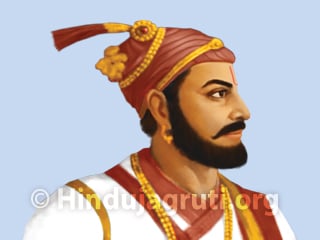
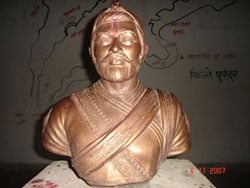
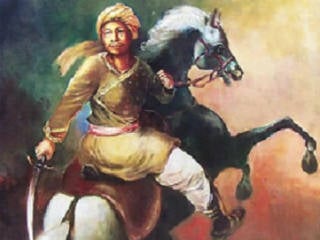 Lachit Borphukan : A great 'unknown' son of Sanatan Dharma
Lachit Borphukan : A great 'unknown' son of Sanatan Dharma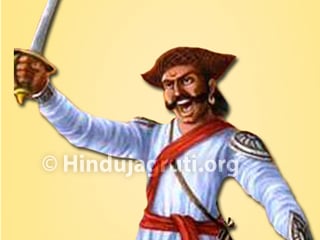 Tanaji Malusare : The conqueror of Sinhagad (the Lion’s Fort)
Tanaji Malusare : The conqueror of Sinhagad (the Lion’s Fort)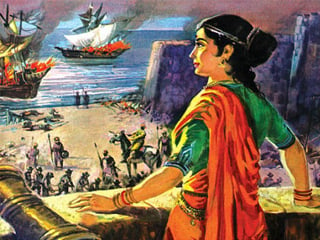 Abbakka Rani : The Warrior Queen who defeated the Portuguese
Abbakka Rani : The Warrior Queen who defeated the Portuguese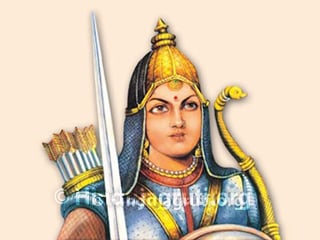 Great Hindu Warrior Queen : Rani Durgavati of Gondwana
Great Hindu Warrior Queen : Rani Durgavati of Gondwana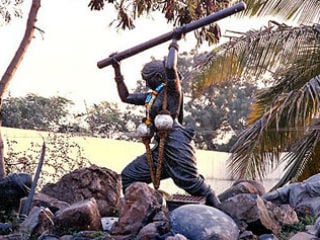 Brave Woman : Onake Obavva
Brave Woman : Onake Obavva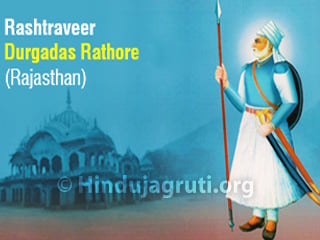 Veer Durgadas Rathore: Savior of Marwar dynasty from clinch of Aurangzeb
Veer Durgadas Rathore: Savior of Marwar dynasty from clinch of Aurangzeb